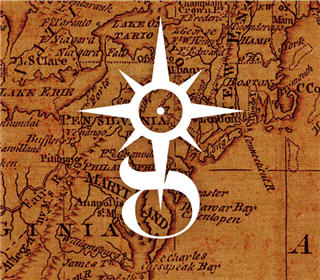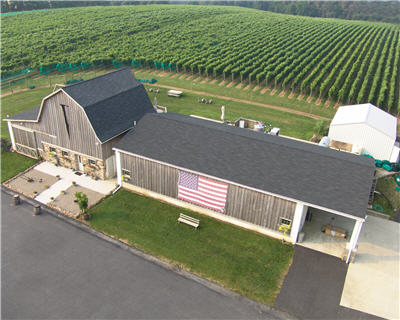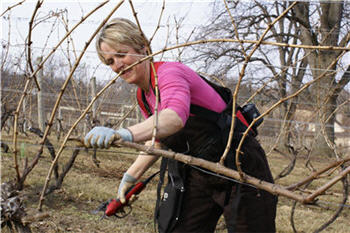

The Stargazers Vineyard logo says it all about Pennsylvania's Brandywine Valley - the stars are lining up for this little known wine region.
Pennsylvania (State Appellation)
Fast-Growing Brandywine Valley
Searches for Terroir-torial Identity
In Philadelphia’s backyard, a winegrowing region attracts tourism, and makes quality gains – but what does it want to be when it grows up?
by
Roger Morris
March 30, 2009
 he Delmarva Peninsula is a mammoth, tear-shaped stretch of flat farmland that spreads across large parts of the three states composing its name - Delaware, Maryland, and Virginia. But at its northern limits, where the Chesapeake Bay pinches in from the west and the Delaware Bay narrows into a river to the east, the plain disappears into a jumble of rolling hills that cross the famous Mason-Dixon line to become part of Pennsylvania’s Chester County.
he Delmarva Peninsula is a mammoth, tear-shaped stretch of flat farmland that spreads across large parts of the three states composing its name - Delaware, Maryland, and Virginia. But at its northern limits, where the Chesapeake Bay pinches in from the west and the Delaware Bay narrows into a river to the east, the plain disappears into a jumble of rolling hills that cross the famous Mason-Dixon line to become part of Pennsylvania’s Chester County.
These hills in turn are well-drained by four fast-flowing creeks, the largest of which is the Brandywine, long a primary tourist destination. The Brandywine Valley, narrow at its terminus but broadening upstream, is an oasis of public gardens, country estates, and art galleries filled with works by Andrew Wyeth and the painters he inspired.
Now, add wine to its beckoning menu.
“It used to be that people would come to Longwood Gardens and maybe stop to see us,” says Mark Harris, one of the owners of Paradocx Vineyards, as Valentine’s Day guests surge around him in the barrel room in search of wine and chocolate. “Now they are coming to see us, with a side trip to Longwood.” Paradocx – so named because the Harrises and Hoffmans who own it are all
 physicians – is one of 10 wineries within the unofficial Brandywine region, two of which crushed grapes for the first time last harvest. Ten years ago, there were just three producers.
physicians – is one of 10 wineries within the unofficial Brandywine region, two of which crushed grapes for the first time last harvest. Ten years ago, there were just three producers.
The area has no official appellation, other than the blanket one of Pennsylvania, but it is becoming well-known largely through the efforts of the Brandywine Valley Wine Trail. Most of the wines made here come from European or vinifera grapes, but the hybrid Chambourcin has also been a steady source of serviceable-to-very-good reds; and Vidal Blanc, another hybrid, makes very pleasant, Pinot Grigio-style whites.
The industry’s rapid success comes from a combination of mostly quality-oriented producers with the marketing skills to draw customers from nearby markets into their tasting rooms, where well over 90 percent of locally produced wines are sold. Philadelphia is less than an hour east, Wilmington is minutes to the south, and Washington is within a 90-minute drive. Even New Yorkers come in numbers every Friday afternoon to fill up the area’s many bed and breakfasts. As a result, the trail sold 1,400 passes for its 2008 spring event and another 1,200 for the fall one.
The pioneer who started all this is an outspoken, second-generation winemaker, Eric Miller, whose late father Mark founded Benmarl in 1957 along the Hudson River. Young Miller and his wife Lee considered California, but instead bought a Colonial-era barn for their winery and tasting room along busy U.S. Route 1 and called it Chaddsford after the nearby town. Their first wine was released in 1983.
The only problem was that there were few grape growers because there was no market. “But from working at Benmarl,” Miller says, “I knew where to buy grapes from along Lake Erie,” located 400 miles away on the other side of the state. Eventually, growers planted vineyards in the Brandywine, most notably John Weygandt at Stargazers Vineyard and Trip Stocki at Smithbridge, who both later started their own wineries.
Two other wineries, Paradocx and Kreutz Creek Vineyards, also started as grape producers. Yet none of these vineyardists were originally farmers. Mark Chien, an Oregon-trained state viticulturalist who has worked for the past decade improving grape growing in the

Anthony Vieta turned his family’s small farm into Va La Vineyards in Avondale, PA.
Similarly, only one winemaker other than Miller has prior commercial winemaking experience – Penns Woods’ Gino Razzi. In 1962, Razzi came from Italy to the U.S. to find work, but ended up in Vietnam as a Marine. After becoming a wine importer, he worked with an Italian winemaker to learn the craft, and, since 1997, his Symposium Montepulciano d’Abruzzo has consistently won top ratings from wine publications.
In 2004, Razzi purchased the old Smithbridge Winery, which had 30-something-year-old Cabernet Sauvignon vines in poor shape, and renamed it Penns Woods. “They didn’t have a lot of information on growing grapes in this region back then,” he says as he drives his SUV around the vineyard on a rainy spring afternoon, so Razzi cut yield 50 percent last year and will another 20 this year.
“Still, I was surprised at what I got on my first attempt,” he says. “Rather than replant the vineyard, I decided to see how good a wine I can make from these old vines.” It’s an intriguing thought. Using mainly purchased regional grapes, his Chardonnays, Sauvignon Blancs, and Bordeaux varietal reds have gotten outstanding reviews, including from his peers. Along with Vietri’s Va La (northern Italian red blends, mainly from Barbera and Nebbiolo, and La Prima Donna white blend) and Miller’s Chaddsford (Chardonnay, Bordeaux red varietals and Italian red blends), Razzi’s Penns Woods completes a triumvirate of top wineries that command top prices.

Vineyardist Jan Grimes learned pruning from wine consultants and now leads the Galer Estate’s vineyard team.
Pharmaceutical researcher and entrepreneur Brad Galer, who recently purchased Folly Hill Vineyard and plans to reopen it in 2010 as Galer Estate, has relied on a tri










 READER FEEDBACK: To post your comments on this story,
READER FEEDBACK: To post your comments on this story,



